Ms-4 June 2010
Written by sales@mbaonlinepapers.com sales@mbaonlinepapers.comMS-4 june-2010
MS-4 : ACCOUNTING AND FINANCE FOR MANAGERS
1."In managing cash, the finance manager faces the problem of compromising the conflicting goals of liquidity and profitability". Comment on this statement. How would you determine the optimum cash balance in a business organisation ?
2. What is meant by appropriate capital structure ? Discuss the determinants and features
of an appropriate capital structure for a corporate body.
3. (a) How is a statement of changes in working capital prepared for 'Fund FlowAnalysis' ?
(b) How is 'cash from operating activities' calculated in cash flow analysis ?
4. Write notes on :
a) Going concern.
b) Return on investment.
(c) Management Accounting.
(d) Capital rationing.
5. Explain differences between :
a) Prime cost and factory cost.
b) First in, First out and Last in, First out methods of inventory valuation.
c) Fixed budget and flexible budget.
d) Contribution and margin of safety.
6.Discuss the features of accounting information which can be generated from accounting
records. How do different users use this information ?
7(a) Following information is available for a company for January and February 2009.
January February
Sales (Rs.) 38 lakh 65 lakh
Profits (Rs.) - 3 lakh
Loss (Rs.) 2.4 lakh –
Compute : (i) Break even sales volume
ii) Profit or loss at Rs. 46 lakh sales
iii)Sales to earn a profit of Rs. 5 lakh.
(b) Calculate Direct Material Cost Variances Direct Material usage variance and Direct Material Price Variance from the following information :
Finished production
during the period 1000 units
Opening Stock of material 1000 kg.
Closing Stock of material 2000 kg.
Value of material purchased Rs. 1 lakh
Standard rate of material Rs. 20 per kg.
Standard quantity of material
per unit of finished product 2 kg.
Quantity of material purchased 4000 units
8. From the following information draw up a balance sheet :
Gross profit ratio 20%, liquidity ratio : 1.5
Reserve : Share Capital 0.5 : 1
Networking Capital Rs. 30 Lakh.
Current ratio 2.5, fixed asset turnover ratio : 2 times
Average Debt collection period : 2 months,
Stock turnover ratio : 6 times (cost of sales/closing stock)
Fixed Asset : Shareholders Net worth 1 : 1
Ms-4 June 2011
Written by sales@mbaonlinepapers.com sales@mbaonlinepapers.comMS-4 june-2011
MS-4 : ACCOUNTING AND FINANCE FOR MANAGERS
1. (a) What do you understand by capitalisation of earnings ? How is the value of a firm
ascertained with the help of its earnings ? Explain with an example.
(b) How can accounting reports, prepared on a historical basis after the closure of an accounting period, be useful to mangers in directing the activities of a business ? Discuss.
2. (a) Explain the terms 'Intangible Assets' and 'Contingent Liabilities' giving suitable examples. How are they treated While preparing the Balance Sheet ? Explain with reasons.
(b) what do you understand by the 'net worth' of a company ? how is it different from the
owners' equity ? What items comprise the net worth ? Is dividend policy connected with the net worth in any way ? Explain.
3. Explain the important determinants of the Working Capital needs of a firm. Can two firms with different Working Capital achieve the same amount of sales ? If so, explain how ?
4. Distinguish between :
(a) Profitability index and Profitability Ratios.
(b) Cash Budget and Cash Flow Statement.
(c) Capitalisation of reserves and Capital Reserve.
(d) Depreciation and Amortisation.
5. Explain fully the following statements :
(a) "Where cash flows are uncertain, the principle will be, greater the variability of cash flows, higher should be the minimum cash balance".
(b) 'Companies with very high profits, generally have a low pay out ratio.'
(c) "Debt is double edged knife".
(d) "Lower the Break-even point, better it is."
6. What do you understand by Budgetary Control ? How is it exercised ? What steps should be taken for installing a Budgetary Control system in an organisation ? Discuss.
7. A company produces a single product which is sold by it presently in the domestic market as Rs.75 per unit. The present production and sales is 40,000 units per month representing 50% of the capacity available. The cost data of the product are as follows :
Variable Cost per unit Rs. 50
Fixed Cost per month Rs. 10 lakh
To improve the profitability, the management has three proposals on hand as under :
(a) to accept an export order for 30,000 units per month at a reduced price of Rs.60 per unit, incurring additional variable cost of Rs. 5 per unit towards export packing, duties, etc.
(b) to increase the domestic market sales by selling to a domestic chain stores 30,000 units at Rs. 55 per unit, retaining the existing sales at the existing price;
(c) to reduce the selling price for the increased domestic sales as advised by the Sales
Department as under;
Reduce Sale Price Increase in Sales
per Unit by Expected
Rs. (in units)
5 10,000
8 30,000
11 35,000
Prepare a table to present the results of the above proposals and give your comments and advice on the proposals.
8. The comparative Balance Sheets of ABC Co Ltd. are given below in condensed form.
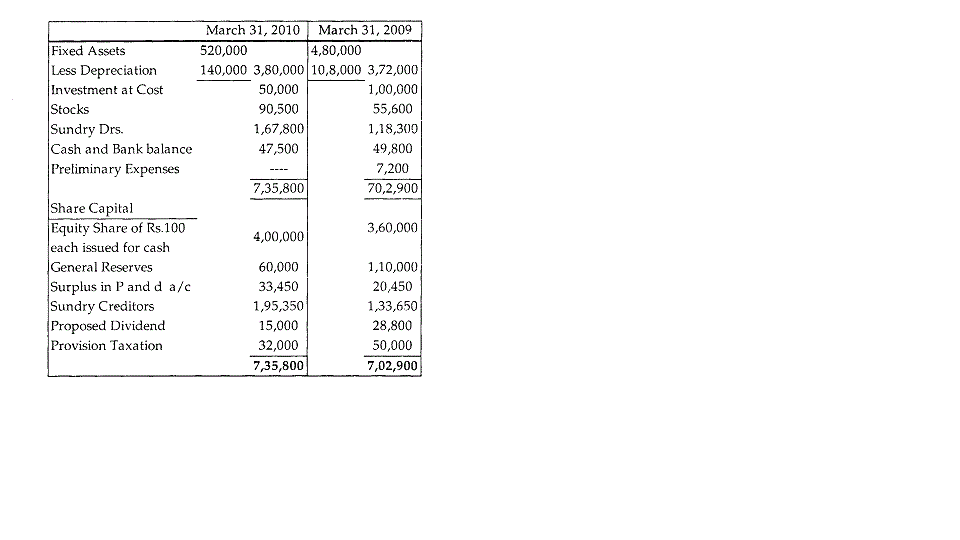
(a) The profit for the year (after providing for depreciation Rs 40,000 writing off preliminary expenses Rs. 7,200 and making provision for taxation Rs. 32,000) amounted to Rs. 38,000.
(b) The company sold during the year old machinery costing Rs. 9,000 for Rs. 3,000.
The accumulated depreciation on this machine was Rs. 8,000.
(c) A portion of the company's investment became worthless and was written off to general reserve. The cost of such investments was Rs. 50,000.
(d) During the year the company paid an interim dividend of Rs. 10,000 and the directors have recommended a final dividend of Rs. 15,000 for the year 2008-09
You are required to :
- (i)prepare a statement of sources
- (ii)and application of funds, and prepare a schedule of working capital changes.
Ms-4 Dec 2007
Written by sales@mbaonlinepapers.com sales@mbaonlinepapers.comMS-4 Dec, 2007
MS-4 : ACCOUNTING AND FINANCE FOR MANAGERS
l. (a) What dq you understand by Accounting Standards ? How do they differ from Accounting Concepts ? Why should the accounting practices be standardised ?
(b) Why are the fixed assets shown at their book value rather than their market value, even if the latter has appreciated significantly ? Give reasons.
2. (a) How would Explain the you compute the cost of goods sold ? Explain two methods of inventory valuation
(b) What is depreciation and what is the rationale behind making a provision for depreciation in the process of matchlng income and expenses ?
3. What do you understand by Zero Base Budgeting ? How does a Zero Base Budget differ from a Flexible Budget ? Discuss the steps involved in Zero Base Budgeting.
4. Distinguish between :
(a) Accounting Rate of Return and Internal Rate of Return
(b) Profitability Index and Profitability Ratios
(c) Bonus Shares and Rights Shares
(d) Earnings yield and Dividend yield
5. A manufacturing company produces and sells products P; Q and R. It has an available machine hour capacity of one lakh hours, interchangeable among the 'three products. Presently the company produces and sells 20,000 units of P and 15,000 units each of Q and R. The unit Selling Price of the three products P, Q and R is Rs. 25, Rs. 32 and Rs. 42 respectively. With this price structure and the aforesaid sales-mix, the company is incurring loss. The total expenditure exclusive of fixed charjes (presently Rs. 5 per unit) is Rs. 13.75 lakhs. The'unit cost ratio amongst the three products P, Q and R is 4 : 6 : 7.
Since the company desires to improve its profitability without changing its cost and price structures, it has been considering-the following three mixes so as to be
Within its total available capacity :
|
Products Mix1 Mix 2 Mix 3 |
|
P 25000 20000 30000 Q 15000 12000 5000 R 10000 1 8000 15000 |
You are required to compute the quantum of loss now incurred and advise the most profitable mix which could be considered by the company.
6. Comment upon the following statements giving appropriate reasons :
(a) Higher net profit margin higher rate of return on investments
(b) EBIT-EPS analysis is an the capital structure. need not necessarily lead to
investment. important tool for designing the capital structure
(c) Cost of retained earnings is lower than the cost of equity.
(d) Many reasons account for direct material variances
- "The conventional break-even analysis is based on a number of assumptions." Explain and illustrate the concept of break-even analysis and justify the above statement.
8. The following three years information is available ior XYZ Ltd. for
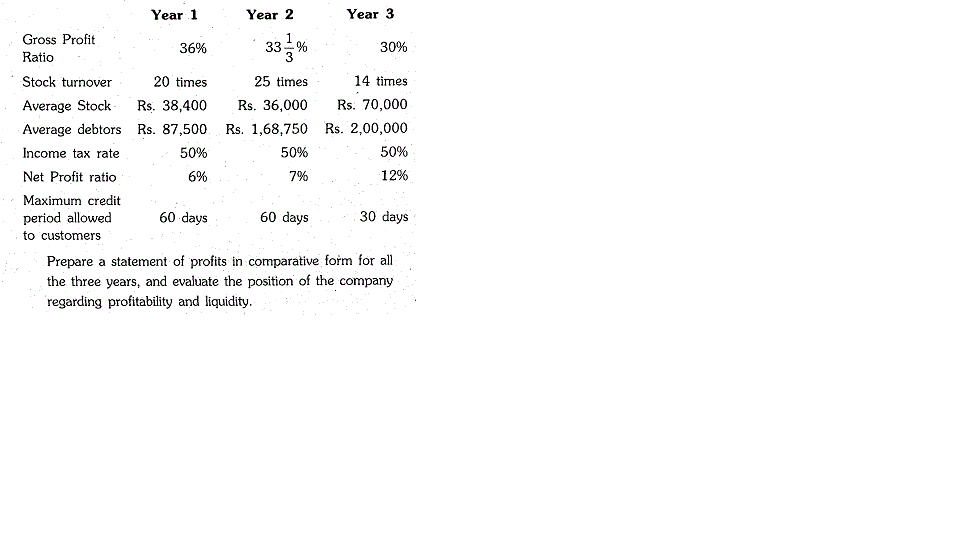
MS-4 DEC 2008
Written by sales@mbaonlinepapers.com sales@mbaonlinepapers.comMS-4 Dec, 2008
MS-4 : ACCOUNTING AND FINANCE FOR MANAGERS
l. (a) Explain the Money Measurement Concept and the Accrual Concept. What are the limitations of the former concept. Explain.
(b) What do you understand by Accounting Standards ? Why are they necessary ? Explain with examples.
2. (a) Explain First-In First-Out and Last-In First-Out Methods of Inventory Valuation. In an inflationary situation, which method will give higher valuation of the inventory, other things remaining the same ? Explain.
(b) what do you understand by Capitalisation of earnings ? How is the value of a firm ascertained with the help of its earnings. Explain with an example
3. what do you understand by Composite Cost of Capital ? How is it computed ? Explain with an example. How would you support the statement that debt becomes more expensive after a certain point is reached ? Explain.
4. Distinguish between
(a) Preference Shares and Bonus Shares.
(b) Earnings Yield and Dividend Yield.
(c) Sales Price Variance and Sales Volume Variance.
(d) Shut Down Costs and Sunk Costs.
5. The summarised result of the operations of a company for the first year of its existence is glven below:
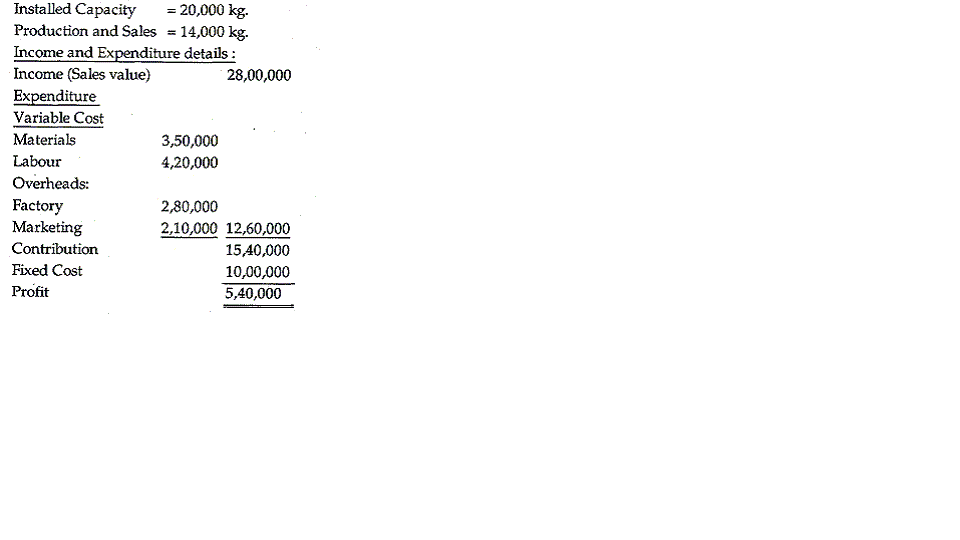
6.What is meant by Net Present Value ? Why is Profitability Index considered useful ? Discuss the Iimitations of Investment Appraisal Techniques.
7.Explain fully the following statements :
(a) Higher profit margins need not necessarily lead to higher rate of return on investement.
(b) Actual performance can be compared with the budget performance with the help of three ratios.
(c) A high operating leverage is not always desirable.
(d) Dividend, Investment and Financing decisions are inter-dependent
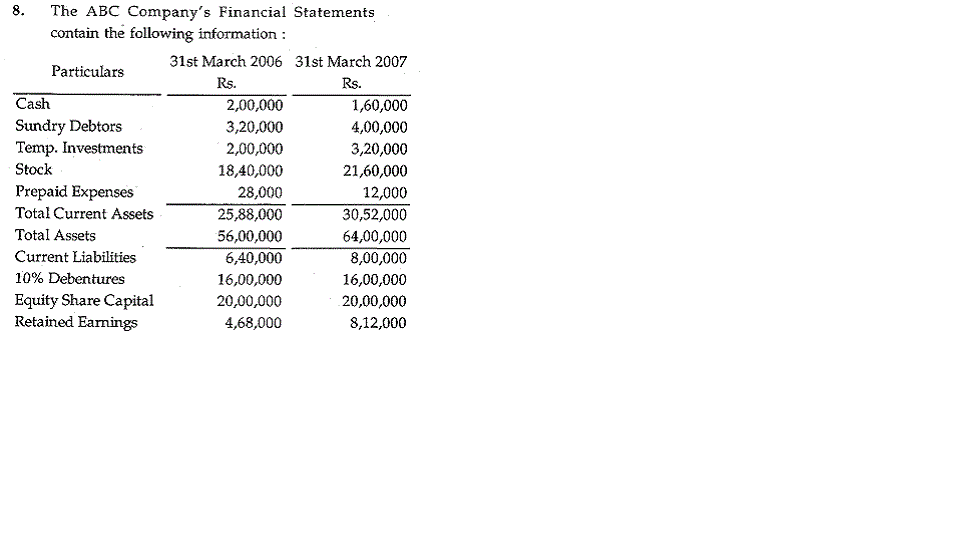
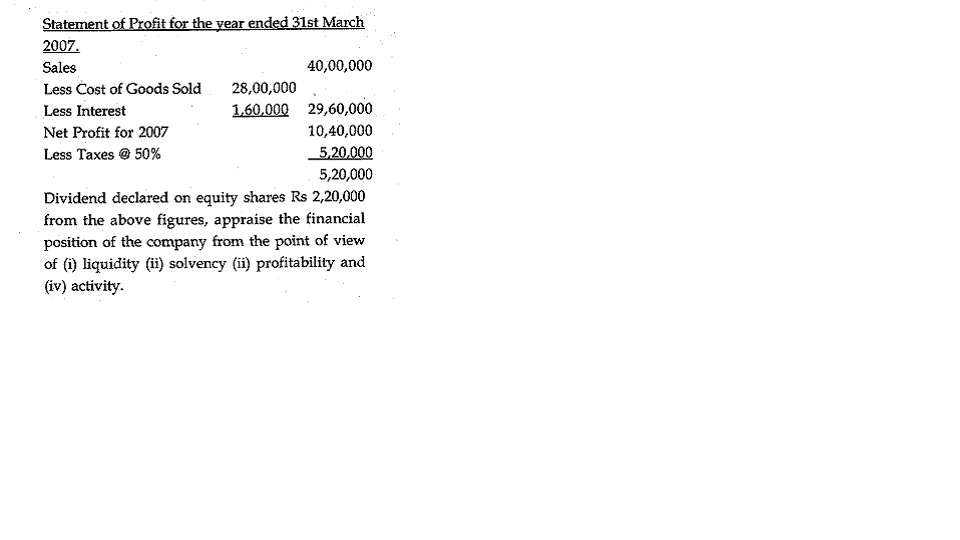
Ms-4 Dec 2009
Written by sales@mbaonlinepapers.com sales@mbaonlinepapers.comMS-4 Dec, 2009
MS-4 : ACCOUNTING AND FINANCE FOR MANAGERS
1. (a) What do you understand by Internal Audit ? How do the functions of an internal auditor differ from that of External Auditor ?
(b) Explain the consistency concept and Accrual Concept of Accounting. How is the Accrual Concept adhered to while preparing the final accounts of a company ?
2. (a) What are intangible assets of a firm ? Why are they shown in the Balance Sheet ? What is meant by amortisation of such assets ? Give reason for the same.
(b) What do you understand by Appropriation of profit of a company ? How are the profits appropriated ? How will the profits to be appropriated, affected, if the company issues debentures, instead of equity shares to finance its activities ? Discuss how ?
3. Distinguish between :
a) FIFO and LIFO methods of Inventory valuation.
b) Rights Shares and Bonus Shares
(c) Direct Material Price Variance and Direct Material Usage Variance
(d) Imputed Costs and Opportunity Costs.
4. What do you understand by Break-even analysis ? Discuss the assumptions underlying the break-even analysis. How do these assumptions make the break-even analysis unrealistic ? Explain and prepare a Break-even chart assuming relevant figures.
5. (a) What do you understand by Flexible Budget ? How does it differ from a Fixed Budget ? Explain its utility to a business organisation.
(b) What do you mean by Control Ratios ? Explain the three important control ratios and discuss their significance.
6. Explain fully the following statements :
a) Operating cycle plays a decisive role in estimating the working capital requirement
of a firm.
b) As there is no explicit cost of retained earnings, they are free of cost.
c) Depreciation acts as a tax shield
d) An investor in shares considers not only its E.P.S. but also P.E. ratio.
7. A company, manufacturing a consumer product and marketing through its network of 400 depots all over the country, is considering closing down the depots and resorting to dealership arrangement. The total turnover of the company is Rs. 200 crore per annum. Average turnover, costs etc in respect of a depot is given below :
Average Turnover Rs. 50 lakh
Average Inventory Rs. 5 lakh
Administration Expenses Rs. 50,000 p.a
Staff Salary Rs. 80,000 p.a
The inventory carrying cost is 16% p.a., which is the rate for working capital finance. Marketing through dealers would involve engaging dealers for each area. The dealers will assure a minimum sale for each area. This would result in increasing the capacity utilisation from 75% as at present to 90%. The Company's P/V Ratio at present is 10% and the Break even point is at 50%of the capacity. Current profit is Rs. 150 lakh. Marketing through dealers would involve payment of a commission of 5% on sales, but 50% of the existing Depot Staff will have to be absorbed in the company. Dealers will deposit Rs. 5 crore with the company on which interest at 12% p.a. will be paid. You are required
- a)to work out the impact on profitability of the company by accepting the proposal as above, and
- b)to give your reaction if the commission to dealers is reduced to 4% on sales.
8. You have the following information on the performance of Premier Co. Ltd. and also the industry averages :
a) Determine the indicated ratios for the Premier Co. Ltd., and
b) Indicate the company's strengths and weakness as shown by your analysis.
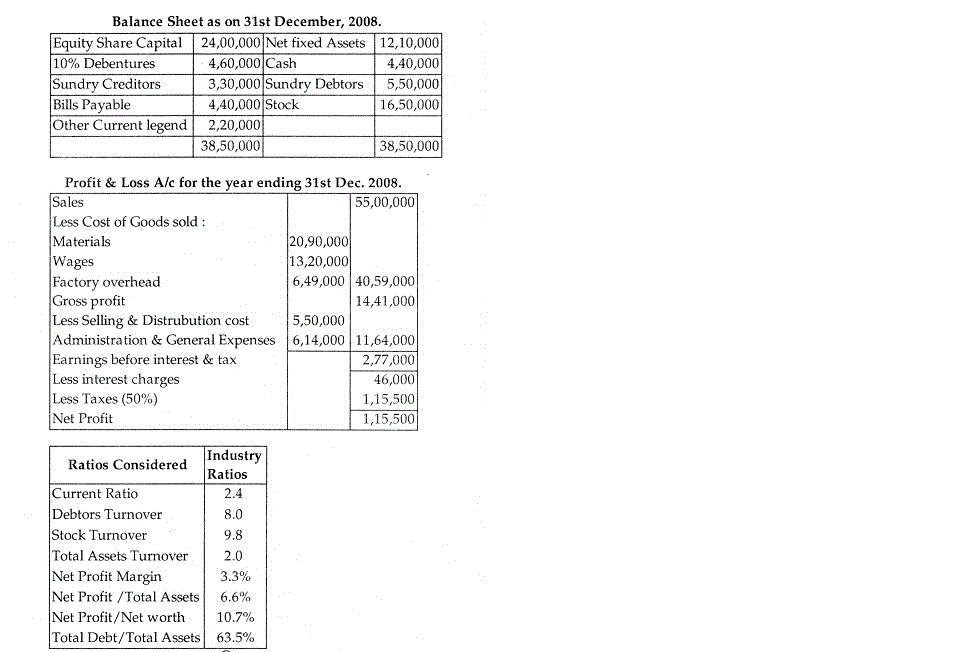
Ms-4 Dec 2010
Written by sales@mbaonlinepapers.com sales@mbaonlinepapers.comMS-4 Dec, 2010
MS-4 : ACCOUNTING AND FINANCE FOR MANAGERS
Ms-4 Dec 2011
Written by sales@mbaonlinepapers.com sales@mbaonlinepapers.comMS-4 Dec, 2011
MS-4 : ACCOUNTING AND FINANCE FOR MANAGERS
1. (a) How does an accountant follow the principle "anticipate no profit, provide for all losses" ? On which accounting concept is this based ? Explain it and discuss its significance.
(b) Distinguish between Financial Accounting and Management Accounting. What is the most important role of a Management Accountant in a business organisation ? Discuss.
2. (a) Distinguish between revenue expenditure and Capital expenditure. How are they treated while preparing the final accounts ? If by mistake the accountant of a firm treats a capital expenditure as revenue expenditure, how will it affect the final accounts of the' firm ? Give an example.
(b) Why is depreciation charged ? Explain the two methods of charging depreciation. In
which method the value of the asset is reduced to zero earlier ? Which one is more rational ? Explain why ?
3. "Financial Leverage is one of the important considerations in planning the capital structure of a company." Explain this statement giving an example. Briefly describe the other factors which are also considered while planning the Capital structure.
4. Distinguish between :
(a) Profit maximisation and Wealth maximisation goals.
(b) Accounting Rate of Return and Internal Rate of Return.
(c) Operating Cash flows and Financial cash flows.
(d) Direct Labour Rate Variance and Direct Labour Efficiency Variance.
5. Explain fully the following statements :
(a) "Break - even Analysis is not without limitations".
(b) "Lenders prefer high interest coverage ratio but a low debt-equity ratio".
(c) "Weighted average cost of capital would always be higher, if market value weights are used."
(d) Zero - based budgeting is a better alternative to traditional method of budgeting.
6. (a) "Sales Budget forms the basis on which all other budgets are built ." Explain. What factors are taken into consideration while preparing the sales budget ? Discuss.
(b) What is Rolling Budget ? How does it differ from flexible Budget ? What purposes
do these budgets serve ? Explain.
7. India Cables Ltd. is manufacturing a special type of cable used by electricity under takings the company is currently working at 80% capacity level. Data on annual sales and costs are as follows:
Sales Rs. 1,200 lakhs
Direct materials Rs. 560 lakhs
Direct Labour Rs. 240 lakhs
Factory overheads Rs. 180 lakhs
(80% fixed)
Selling, distribution and
Administration expenses
Rs 100 lakhs
(60% variable)
The company has just received an export order which requires utilisation of 40% of the plant capacity. The order can not be split and has to be executed in one lot as quickly as possible. The price offered is 10% lower than the current domestic price. Further, it will be necessary to spend 10% more on variable selling distribution and administration expenses because of the special type of export packing required. The company is considering the following options.
(a) reject the export order and carry on with the domestic sales.
(b) accept the export order and allow the domestic sales to fall to the extent required.
(c) Create additional plant capacity by installing new machinery which will result
in increase of fixed costs by Rs. 20 lakhs per annum.
Evaluate each of these options and suggest the best course of action for the company, assuming that the export order will continue in future years also.
8. From the following details furnished by Global Traders for the year ended March 31,2010 prepare its Balance Sheet as on that date :
Current Ratio 1.75
Quick Ratio 1.25
Gross Profit Ratio 25%
Reserves and surplus : capital 0.2
Stock Turnover 9
(cost of sales : closing stock)
Average collection period of 11/2 months
credit sales
Cost of sales : Fixed Assets 1.2
Debt : Equity Ratio 0.6
Fixed Assets : Net worth 1.25
The firm sells its products only on credit, credit sales for the year ended March 31,2010 amounted to Rs. 120 lakhs.
MS-3 – June-2007
Written by sales@mbaonlinepapers.com sales@mbaonlinepapers.comMS-3 – June-2007
MS-3 : ECONOMIC AND SOCIAL ENVIRONMENT
1 (a) What is Environmental Movement ?
(b) Discuss in detail the policy measures taken by the Government and the efforts made by business firms for promotion and protection of the nafural
environment. Give examples.
2. What is the rationale for private sector development ? Critically examine the problems and prospects of privatisation.
3. What are the long term objectives of planning ? How far have the strategies adopted helped to achieve growth, employement, and equity ?
4(a) Discuss the merits and demerits of currency convertibility for a developing economy.
(b) Discuss the incentives given by the Government to Exporters as a part of EXIM Policy.
5. (a) briefly discuss the significance and need for financial reforms
(b) What reforms have taken place in the Small Scale Sector ? Discuss with example
MS-3 – June-2008
Written by sales@mbaonlinepapers.com sales@mbaonlinepapers.comMS-3 – June-2008
MS-3 : ECONOMIC AND SOCIAL ENVIRONMENT
1. Discuss the salient features of the New Economic Policy and the initiatives taken by the government for economic restnrcturing.
2. Describe the institutional framework for Small Scale Industry (SSI) which emerged over the period.
3. (a) Discuss the salient features of the Gandhian Model of Development and its relevance in the current context.
(b) "The overall performance of public sector enterprises (PSEs) has been poor."
Do you agree with the above statement ? why ? Why not ? Give reasons.
4. Describe the various kinds of external debt. Critically evaluate the growing debt servicing burden of India and the challenges associated with increasing debt burden
5. Critically examine the recommendations of the Narasimhan Committee"
6. Give your comments on the following statements :
(a) Effective opposition is as important as a dedicated govemment to protect, promote, regulate business in the best interest of society.
(b) Industrial sickness is essentially a managerial failure.
(c) The distinction between Capitalism and Communism has become thin.
(d) The remarkable upsurge in foreign investments and collaborations in the 90s is largely due to policy liberalisation.
(e) Economic reforms have failed to provide social security.
7. Write short notes on any four of the following :
(a) The Environmental Movement
(b) Mixed Economic Framework
(c) Economic Reforms and Inflation
(d) Privatisation
(e) Social Responsibility of business
(f) Horizontal versus Vertical equity
MS-3 – June-2009
Written by sales@mbaonlinepapers.com sales@mbaonlinepapers.comMS-3 – June-2009
MS-3 : ECONOMIC AND SOCIAL ENVIRONMENT
1.. Discuss the interaction matrix of economic and non-economic environment. How does the economic environment influence the non-economic environment of business and vice versa ? Explain with suitable examples.
2. what are the objectives of public sector? Elaborate the objectives which resulted in the growth of the public sector. Do you think public sector is critical to the growth of the economy ? Comment.
3. Discuss the main strategies that have been adopted since the beginning of Second Plan (1956). Also highlight the limitations' if any of these strategies in the current context.
4. How does the exchange rate of a nation's currency influence the balance of payments of an economy? Explain in terms of rupee convertibility on both the current and capital accounts'
5. "Financial sector reforms constitute an important component of the prograrnme
of stabilization and structural reform''.Elaborate the statement in the light of financial sector reforms in relation to public sctor banks.
More...
MS-3 – June-2010
Written by sales@mbaonlinepapers.com sales@mbaonlinepapers.comMS-3 – June-2010
MS-3 : ECONOMIC AND SOCIAL ENVIRONMENT
1. What do you think are the defining characteristics of economic and non-economic environment ? How do these environments impact the business ? Explain with examples.
2. (a) 'The small scale industry has found a place of prominence in the successive industrial policies of India'. Keeping this statement in mind, elaborate upon the industrial policy for small scale industries (SSI).
(b) Explain the institutional infrastructure at the central level institutions for SSIs.
3. Experts often argue that industrial licensing policy has impeded competition in India. Evaluate this statement in the light of objectives of industrial licensing policy in India.
4. Explain the EXIM policy charges effected in 1991. How are such measures different from the EXIM policies pursued earlier ?
5. (a) Identify the fundamental differences between exclusive and inclusive growth.
(b) Critically examine the new economic reforms from the viewpoint of its impact on employment.
6. Comment on each of the following statements :
a) India's indebtedness position has improved in recent time
b) India's capital account is now partially convertible.
c) Liberalisation, globalisation and privatization are all means to achieve certain ends of the society.
d) New focus in MRTP act.
7. Write short notes on any four of the following :
a) Balance of payments
b) Tariff and non-tariff barriers
c) Fiscal deficit and revenue deficit
d) Financial Asset structure of household section.
(e) Rao - Manmohan Model of development.
MS-3 – june-2011
Written by sales@mbaonlinepapers.com sales@mbaonlinepapers.comMS-3 – June-2011
MS-3 : ECONOMIC AND SOCIAL ENVIRONMENT
1. Examine the interaction between economic environment and business management. How the environment and management influence each other ? Explain with suitable examples.
2. "The economic environment of business exercises a strong influence on the non-economic environment of business and vice versa". Briefly discuss citing specific interactions.
3. "India today has one of the most diversified industrial structures in the world." Examine the basic structural changes in the economy in the light of the above statement.
5. What are the principal elements of Industrial Policy of 1980 ? Compare it with the Industrial Policy of 1991 and discuss.
6. "Foreign investment and technology will largely be beneficial to India's industrialisation and economic development". In the light of this discuss foreign investment policy and foreign collaborations in the post reform period.
7. Write short notes on any four of the following :
(a) Changing role of Government
(b) Industrial Sickness
(c) Revenue Deficit
(d) Rao - Manmohan Model of Development
(e) Administered Prices
MS-3 – Dec-2007
Written by sales@mbaonlinepapers.com sales@mbaonlinepapers.comMS-3 – Dec-2007
MS-3 : ECONOMIC AND SOCIAL ENVIRONMENT
1. "The management movement in India has been relatively strong and distinct." Discuss the statement giving examples.
2. Explain industrial sickness. What are the factors responsible for sickness in small scale industry ? What remedial measures would you suggest for tackling the problem ?
3. Critically examine whether the regulatory and promotional policy framework is in accordance with the following goals and objectives of the economy :
(a) To achieve full employment, and
(b) To reduce inequalities in income and wealth.
4. What is the role of external debt in the economic development of a country and what are the implications of a growing external debt ? What measures are needed to check the growth of debt servicing burden ?
5- critically examine the Indian financial system in detail.
6. Comment on the following statements :
(a) Government involvement in Indian economy is a necessity.
(b) currently, consumers in India are conscious of their rights.
(c) Managers in the public sector are simirar to those in private sector; it is the work culture which is the impediment to higher efficiency.
(d) Although business is an economic activity, economic environment of business cannot be considered in isolation. It has to be considered in line with other social, cultural and technological factors.
(e) By keeping the doors open to multinational corporations, India is able to proceed along the.desired path of development.
7. Write short notes on any four :
(a) Social security
(b) Economic reforms and poverty
{c) Social responsibilities of business
(d) Mixed economy
(e) Economic growth
(f) Balance of payments
Ms-3 Dec 2008
Written by sales@mbaonlinepapers.com sales@mbaonlinepapers.comMS-3 – Dec-2008
MS-3 : ECONOMIC AND SOCIAL ENVIRONMENT
1. Explain the critical elements of economic environment, giving examples. What, according to you, are the landmark developments of economic environment in India ?
2; Critically evaluate impact of' structural changes in Indian industry on the industrial growth experience.
3. Discuss the issues and impediments to growth of India's foreign trade in the post-reform period.
4. Critically examine the tax reforms and rccent developments in the taxation policy and its impact on the fiscal position of the govemment.
5. Write short notes on any four of the following :
(a) Role of the Government
(b) Industrial Sickness
(c) Public Accountability
(d) Administered Prices
(e) Public Debt
